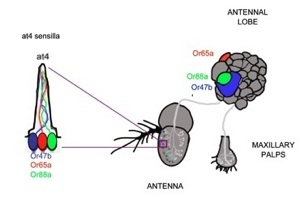
Each ORN arises from developmentally related and asymmetrically dividing olfactory progenitor cells in the adult olfactory system. Thus, specification of 50 unique sensory identities from these progenitors presents a fascinating problem of developmental biology and a major regulatory challenge to sensory receptor expression. OR expression pattern in the Drosophila olfactory appendages is very deterministic and the pairing of OR expression within specific sensilla is conserved. For example, in the antennal at4 sensilla, which has been shown to have a role in pheromone detection, Or47b expressing ORN are always clustered with Or88a and Or65a expressing ORNs. One might imagine that this deterministic pattern of OR expression could be achieved spatio-temporally through sequential restriction of OR expression competency during development. Indeed, initial restriction of ORN sensory identity is generated as olfactory precursors are assigned to different transcription factor lineages. Different lineages designate morphologically distinct classes of sensilla in specific antennal zones, and ultimately define the OR subset that will be expressed in the ORNs of these sensilla. Consequently, ORN pairs in each sensillum are formed through asymmetric divisions from different olfactory precursor cells, and adopt their final OR expression profile. Thus, the OR competency during these processes might be regulated by combinations of transcription factors and by different chromatin states at the OR promoters in different sensilla.
In the same genetic screen we recovered mutants in a DNA-binding protein with suggested function in chromatin-mediated gene silencing that regulates OR choice specifically among at4 ORNs. We are currently elucidating developmental and molecular function of of this gene as well as other epigenetic factors in sensory specification of ORNs and how such changes in circuit morphology affect pheromone mediated behaviors.